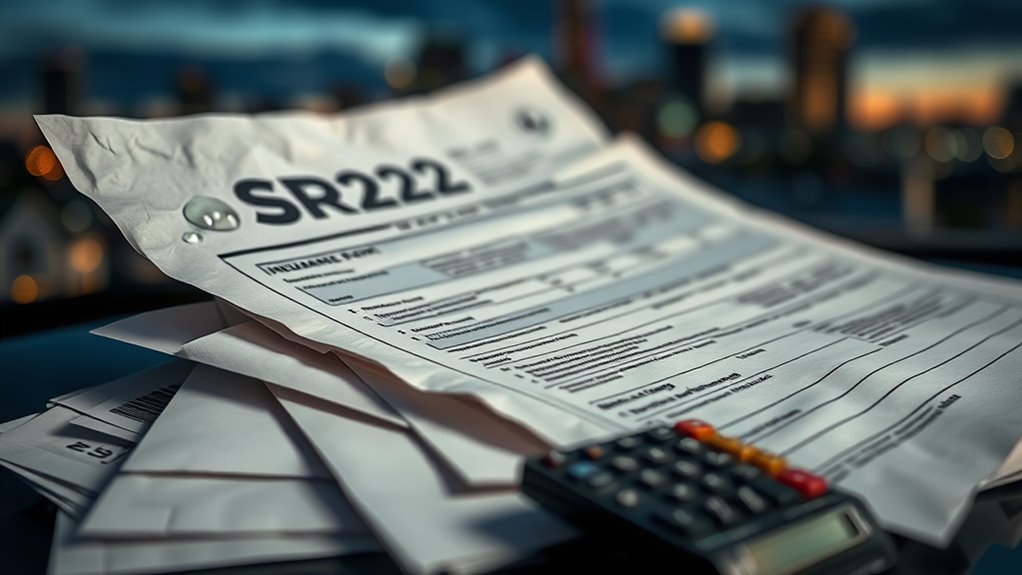7 Best Financial Penalties for SR22 Non-Compliance
Many drivers underestimate the financial repercussions of failing to comply with SR22 requirements. Non-compliance can trigger a cascade of penalties, impacting your wallet more than you might expect. Increased insurance premiums, hefty reinstatement fees, and even extended SR22 durations can complicate your financial landscape. Understanding these consequences is essential to avoiding unnecessary strain. So, what are the specific penalties you should be aware of?
Key Takeaways
- Failure to maintain SR22 coverage can lead to license suspension and extended SR22 requirements, increasing overall costs.
- Non-compliance may result in additional reinstatement fees, with costs varying significantly by state.
- Increased insurance premiums can occur when marked as high-risk due to SR22 non-compliance, impacting monthly budgets.
- Lenders may impose higher interest rates or less favorable loan terms due to the financial risk associated with SR22 violations.
- Canceling an SR22 policy can incur non-refundable filing fees, compounding financial penalties for non-compliance.
Increased Insurance Premiums

Increased insurance premiums are a common consequence for drivers required to file an SR22 form, marking them as high-risk in the eyes of insurers. You might see monthly increases averaging around $120.25, greatly influenced by factors like the type of violation, such as DUI, which can spike rates by over 50%. State variations also play a role, as differing minimum liability requirements and regional costs affect premiums. Additionally, affordable SR22 insurance options may be available for some drivers, which can help mitigate these costs. More severe offenses, including repeated traffic violations or at-fault accidents, compound these increases. Additionally, a suspended license can significantly impact your insurance rates for a duration of 3 to 5 years. Since insurance providers assess risk differently, it's essential for you to compare quotes to find the most affordable SR22 coverage, particularly during the mandatory 3-5 year period following your violation.
SR22 Filing Fees
Maneuvering SR22 filing fees is an essential aspect of maintaining compliance after a serious driving violation. Typically, these fees range from $25 to $50 per filing, but they can vary based on your state and insurance provider.
Remember, this fee is usually a one-time charge separate from your insurance premiums. Some states may require upfront payment, so be prepared for that when filing.
While the SR22 serves as proof of financial responsibility, it doesn't necessitate additional coverage beyond state minimums.
Keep in mind that if your policy is canceled, the filing fees are non-refundable. Ensuring timely payment of these fees is vital to avoid further penalties and maintain your driving privileges.
Reinstatement Fees
Reinstatement fees for SR22 non-compliance can vary dramatically across states, and understanding these costs is vital for anyone looking to regain their driving privileges.
For example, Tennessee charges a $100 reinstatement fee plus a $50 SR-22 fee, while Missouri imposes a more modest $20 fee. Ohio's reinstatement fee isn't specified but is required alongside serving a suspension and filing SR-22 forms.
Additional charges, such as online payment service fees, may also apply. Costs can escalate if you have multiple infractions or suspensions.
It's essential to stay informed about your state's specific requirements and potential waivers, as these can greatly influence your financial obligations during the reinstatement process.
Extended SR22 Duration

Extended SR22 durations can considerably affect your driving privileges and financial obligations. If your SR22 coverage lapses, your insurance company must notify the DMV, potentially leading to license suspension.
Additionally, failing to comply can extend the required SR22 period, increasing your financial burdens. Serious offenses like DUI or reckless driving typically necessitate longer SR22 durations, often for three years. Accumulating multiple violations or driving without insurance can also trigger extended requirements.
Each state varies in its regulations, meaning you must understand your local laws. To avoid complications, it's essential to maintain uninterrupted insurance coverage throughout the SR22 period, as continuous compliance is vital for regaining full driving privileges and minimizing financial impacts.
Higher Liability Coverage Requirements
When you're required to file an SR-22, understanding the higher liability coverage requirements is critical for maintaining your driving privileges. These requirements vary by state and are often enforced for serious driving offenses.
Key points to reflect on include:
- Higher liability coverage guarantees financial responsibility, reflecting your risk profile.
- States like Florida and Virginia may mandate specific forms, such as FR-44, with elevated limits.
- The type of SR-22 insurance—owner, operator, or combined—affects your coverage and costs.
- Failing to maintain this coverage can lead to severe penalties, including license revocation.
Being proactive about these requirements helps you avoid complications and guarantees you stay compliant while driving.
Daily Fines for Non-Compliance
Although daily fines for SR-22 non-compliance aren't common, the financial repercussions of failing to maintain required coverage can quickly add up.
Most states impose larger fines upon conviction, and a lapse in coverage can lead to license suspensions and significant reinstatement fees. Common triggers, like driving without insurance or DUI offenses, often escalate the penalties.
Courts may impose additional fines if you don't promptly reinstate your insurance after a lapse. Continuous lapses mean you could face cycles of fines and fees, further straining your finances.
Maintaining consistent insurance coverage throughout the SR-22 requirement period is vital in avoiding these additional costs and ensuring compliance with state regulations. Ignoring this can lead to long-term financial complications.
Impact on Loan and Financing Opportunities

How does having an SR-22 affect your chances of securing a loan? While the SR-22 requirement itself doesn't directly hinder loan approval, it can signal higher risk to lenders, impacting your financial reputation.
Here's what you need to take into account:
- Financial Stability: SR-22 may indicate increased financial risk, complicating your approval chances.
- Higher Costs: Increased insurance premiums can strain your overall financial situation.
- Interest Rates: You might face higher interest rates due to perceived risk.
- Loan Terms: Lenders may offer less favorable terms, such as shorter repayment periods.
Understanding these factors can help you navigate the loan landscape effectively despite SR-22 implications.
Being proactive in your financial planning can improve your chances of securing better loan options.
Conclusion
In short, non-compliance with SR22 requirements can hit you hard financially. Think of it like a snowball rolling down a hill—it starts small, but as it gathers speed, it becomes a much bigger burden. Increased premiums, filing fees, and extended durations can quickly stack up, making it tough to regain your financial footing. Staying compliant not only saves you money but also keeps your driving record clean, allowing you to navigate the road ahead with confidence.
